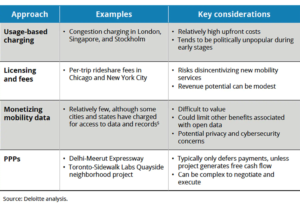Most governments rely heavily on revenue generated directly and indirectly by transportation. Everything from fuel taxes to parking fees, traffic violation fines, value-added taxes from vehicle purchases, subway and bus fares, and registration and licensing charges can provide critical revenue to maintain infrastructure, support public transit, and more.
Those reliable sources of funding could come under increasing strain, according to research by Deloitte. The growth in e-mobility could reduce tax receipts from fuel. Shared mobility services may lead to less car ownership altogether, which would lead to declining revenue from sales taxes and licensing and registration fees. And, if autonomous vehicles take off, traffic violations and demand for parking could plummet.
New ways of funding for future mobility
Governments have explored a number of ways to help shift transportation-derived revenue away from traditional sources like fuel taxes. Four broad approaches have either proved successful, attracted interest from some governments, or may emerge in line with new technology: usage-based charging, licenses and fees, monetizing mobility data, and public-private partnerships (PPPs). All four approaches have advantages, limitations, and potential challenges.
A strategic approach to funding mobility
The approaches to funding are rarely mutually exclusive. When crafting a mobility funding strategy, governments should consider what mix of policies can best meet their needs, according to Deloitte.
But all projects should generally start with the same set of preliminary steps:
- Understand the business model the proposed project will follow, including financial dynamics, potential risks, when costs will be incurred, and when revenue will start to flow (including potential sources of revenue). Participants also should determine whether the project will generate cash after all costs have been paid that can be used to repay any external financing.
- Understand the value generated directly by a project (such as through the ability to charge usage fees) and indirectly (through the increased value of adjacent land). Governments should make efforts to capture a portion of this value generated to assist funding the specific project or future expenditures.
- Determine the financing options available from public or private sources, debt, or equity, depending on expected levels of cash flow and value capture opportunities.
- Create a procurement and delivery model to ensure the project achieves the required outcomes, including optimal risk transfer. Government should look to build flexibility into any agreements to avoid being “locked in” as technology develops and to make it easier to stitch together plans that cover multiple geographies.
When evaluating the suitability of a particular approach, public sector leaders should also consider the political and technical complexities involved. Some approaches may face resistance from key stakeholders, requiring awareness building and education, outreach, and deft management.
Read the full article on the Deloitte website (source).

